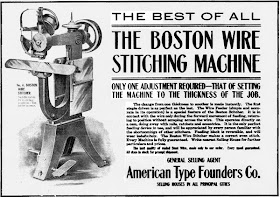The Ace has the patent number stamped on it:
The patent goes all the way back to 1936. The inventor, a Chicagoan named William G. Pankonin, also held patents for the Ace stapler made by the Ace Fastener Corporation, also of Chicago. So, it seems likely that Ace was the first to produce and market this device. (Ace is still around, now as Ace Fastener & Manufacturing, Inc. out of Camden, N.J.)
Incorporated in 1890, the Bates Manufacturing Company operated out of Orange, New Jersey making and selling automatic hand-held numbering machines.
 |
| Bates Manufacturing Company |
The company that was to become Swingline was founded by Jack Linsky as the Parrot Speed Fastener Company in 1925 in New York City. It opened its first factory on Long Island in 1931. In 1939, it produced a revolutionary stapler that used rows of staples glued together, which were inserted from the top. The Swingline name only came along in 1956.
Bostitch dates back to the Boston Wire Stitcher Company, founded by Thomas Briggs in 1896 in Arlington, Massachusetts. He had invented a Wire Stitcher to use for fastening books, calendars, hat boxes and whatever. A foot-operated stapling machine came along in 1903 and a desk stapler in 1913.
 |
| Museum of Texas Tech University |
In 1924, they introduced the first cemented strip staples (a decade before Swingline). During World War II, they manufactured parts for, and assembled, the M1918 Browning Automatic Rifle. In 1948, the company combined its name into "Bostitch." In 1966 they were acquired by Textron, from which Stanley purchased the firm in 1986. Stanley now makes the Bostitch staple removers in China.
Update, March 30, 2017. A recent find, an APSCO (Automatic Pencil Sharpener Company) 200 tool marked "Toronto, Ont Can" and "Made in Sweden." That tells me that APSCO had a Canadian subsidiary, and that at least some of their office tools were made in Sweden. The company's gone, and I've yet to find much information on it.








No comments:
Post a Comment